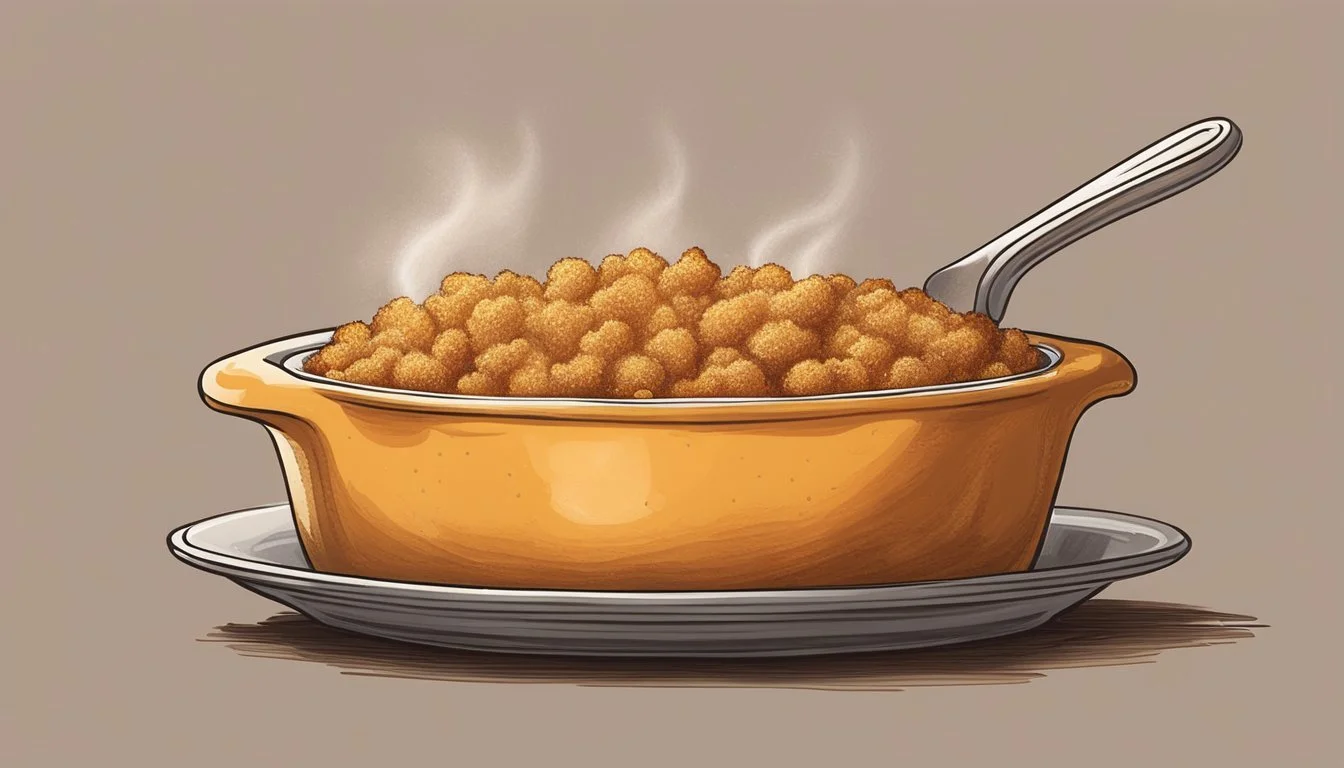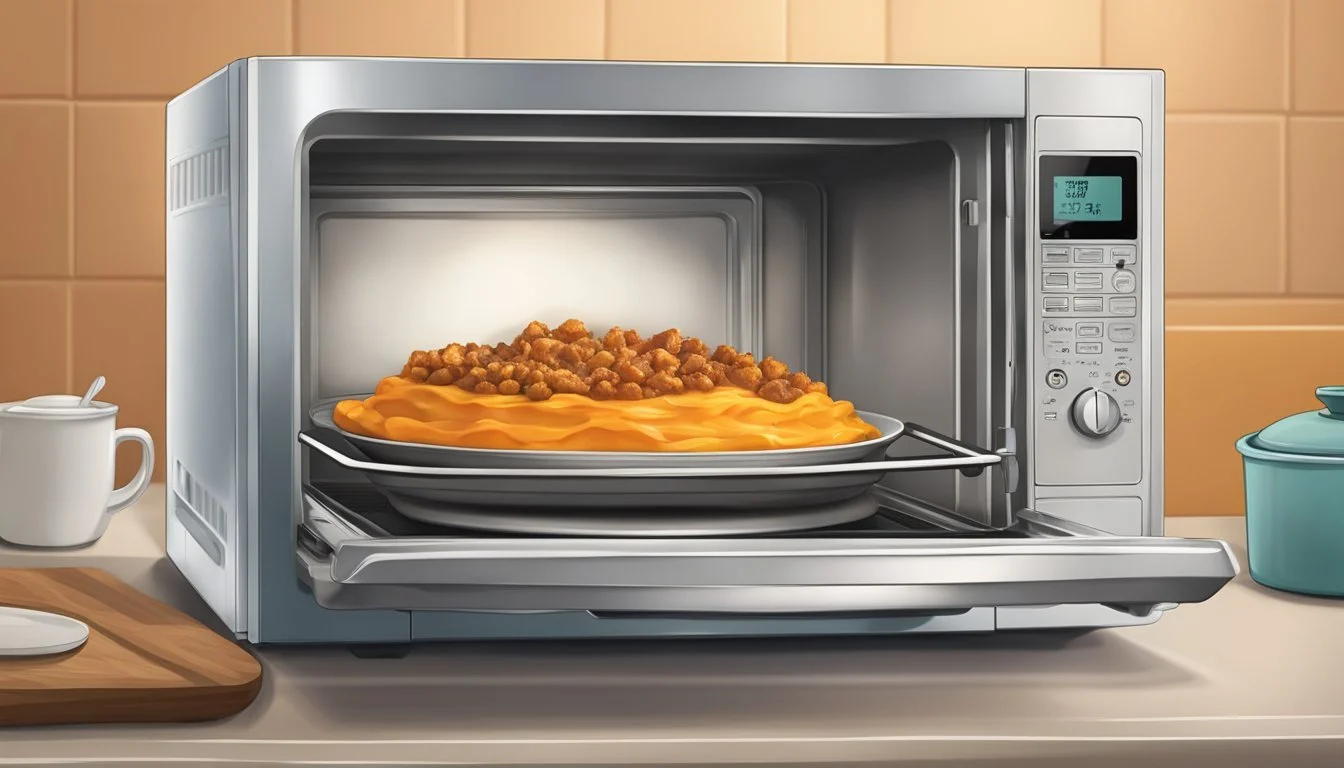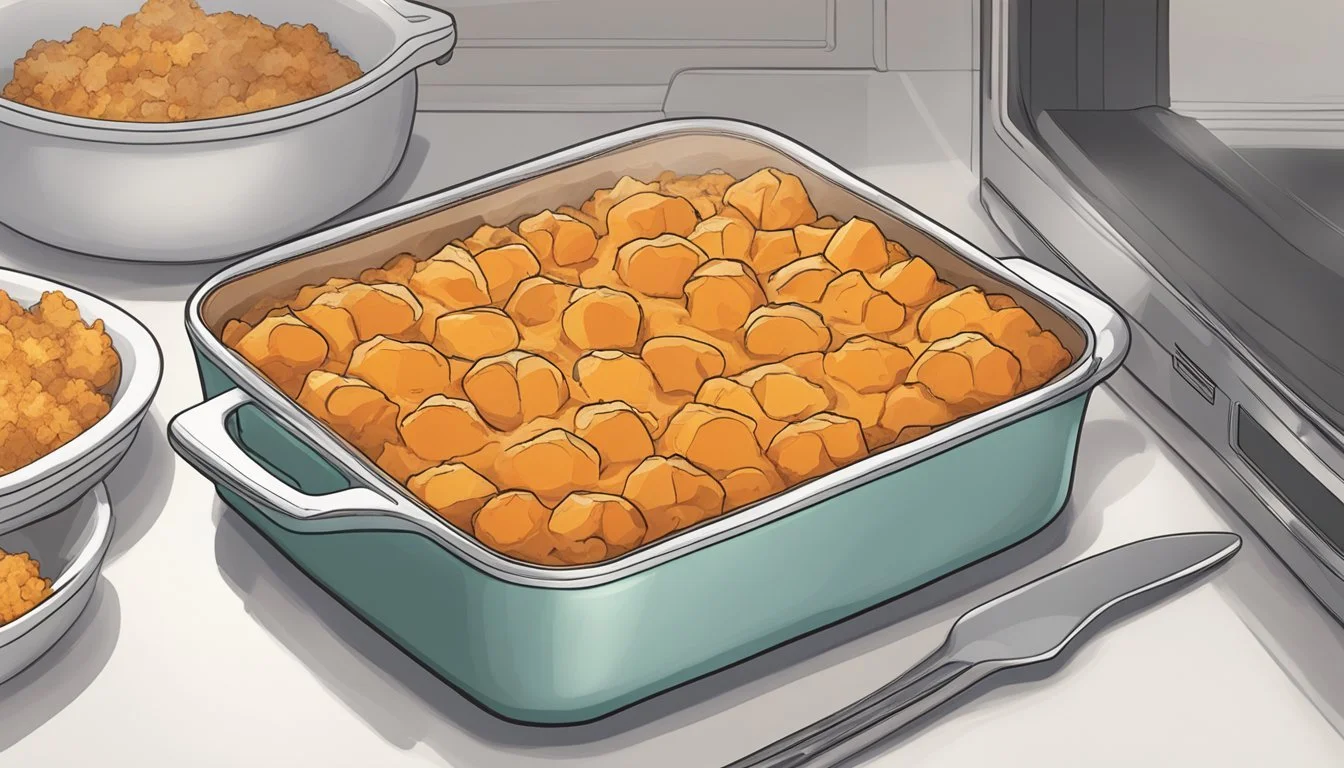Best Way to Reheat a Sweet Potato Casserole
Maintaining Fluffiness and Flavor
Sweet potato casserole is a beloved comfort food, often gracing tables during holidays and cozy family dinners alike. Its appeal lies in the fluffy, tender texture and the warm, spiced sweetness that makes it a crowd-pleaser. However, when it comes to reheating leftovers, retaining that sought-after fluffiness can be a challenge. The key to a successful reheat lies in the method chosen, which can significantly affect the texture and flavor of the dish.
Several reheating techniques can ensure a sweet potato casserole remains just as enjoyable the second time around. For instance, the microwave offers convenience and speed, but demands a careful approach to prevent the casserole from becoming too dry or unevenly heated. Alternatively, an oven reheat, though slower, typically provides a more even warmth, helping to preserve the casserole's moisture and fluffiness. It is essential to understand the nuances of each method to select the best reheating strategy.
When considering how to reheat sweet potato casserole, maintaining the delicate balance of moisture and texture is paramount. Covering the dish can trap steam and prevent the casserole from drying out, while setting the correct temperature ensures that it heats through without overcooking. Ensuring the sweet potato casserole returns to its former glory requires careful attention to these details, making the difference between a merely acceptable outcome and a delectable one.
Understanding Sweet Potato Casserole
Sweet potato casserole is a rich, spiced dish often featuring a variety of textures and flavors, from a velvety base to a crunchy topping. This section sheds light on its ingredients, its significance in culinary traditions, and its versatility as both a dessert and a side dish.
Composition and Key Ingredients
The foundation of a sweet potato casserole lies in its sweet potatoes (What wine goes well with potatoes?), which provide a smooth and creamy texture once mashed. Essential ingredients like butter, milk, and brown sugar are often added to enhance its richness and sweetness. For depth of flavor, cinnamon and nutmeg are commonly incorporated, while maple syrup can offer a note of woodsy sweetness. A traditional topping might include marshmallows or pecans, adding a contrasting texture that complements the soft base.
Culinary Importance
Sweet potato casserole is a staple at many American holiday tables, especially during Thanksgiving and Christmas. As a reflection of its culinary importance, this dish is synonymous with comfort food and is a quintessential item at potlucks. It embodies the warm, indulgent flavors that are characteristic of festive and communal meals.
Service as Dessert or Side Dish
Traditionally, sweet potato casserole is served as a side dish, but its inherent sweetness allows it to double as a dessert. The versatility stems from its sweet ingredients, making it a beloved finale for many festive meals. Whether topped with toasted marshmallows for a dessert-like appeal or baked with a pecan crumble for a savory edge, sweet potato casserole fits seamlessly into the dining experience.
Preparation Before Reheating
Proper preparation is crucial to ensure that a sweet potato casserole retains its quality when reheated. From adequate cooling and storage to the correct transition to room temperature, each step plays a vital role in preserving the casserole's fluffiness and taste.
Cooling and Storage Methods
After enjoying a meal, one must allow the leftovers of sweet potato casserole to cool completely to room temperature. This avoids condensation inside the storage container, which can make the casserole soggy. Then, they should be covered securely with aluminum foil or transferred to an airtight container and stored in the fridge. Refrigeration is ideal for short-term storage, keeping it safe for consumption for up to 3-5 days.
From Fridge to Room Temperature
Before reheating, gently bring the casserole from the fridge to room temperature; this allows for more even warming and reduces the risk of drying out the dish. The casserole should sit out for approximately 20-30 minutes, ensuring none of its parts remains overly cold which could lead to uneven reheating.
Dealing with Freezer Storage
For those who have opted to freeze their sweet potato casserole for long-term storage, it’s essential to plan ahead. The dish should be thawed safely in the fridge, a process that may take several hours or overnight, depending on the casserole's size. Once thawed, remove the casserole from the fridge and let it reach room temperature before proceeding to reheat. Food safety guidelines suggest reheating food only once after thawing from the freezer to maintain quality and safety.
Reheating Sweet Potato Casserole
Reheating sweet potato casserole properly ensures the dish retains its fluffy texture and savory flavor. The method chosen can affect the moisture content and final quality.
Oven Reheating
To reheat sweet potato casserole in an oven:
Preheat the oven to 350°F (175°C).
Place the casserole in an oven-safe dish, covered with foil to retain moisture.
Heat for about 20-30 minutes, checking occasionally to avoid overcooking.
Microwave Method
For a quick reheating method using a microwave:
Place the casserole in a microwave-safe dish.
Cover with a lid or plastic wrap, slightly vented.
Reheat on medium power, in 1-minute intervals, stirring occasionally.
Stovetop Warming
Using a stovetop to warm up leftovers:
Transfer the casserole to a non-stick skillet.
Cover and warm over low heat, stirring occasionally to distribute heat.
Utilizing an Air Fryer
For a crispier top layer when reheating with an air fryer:
Preheat the air fryer to 375°F.
Place the casserole portion in the basket; heat for 3-5 minutes.
Toaster Oven Technique
The toaster oven is ideal for reheating individual servings:
Preheat the toaster oven to 350°F.
Place the serving in an oven-safe dish and toast for 5-10 minutes.
Ensuring Quality and Consistency
To achieve the best reheating results for a sweet potato casserole, one needs to focus on methods that preserve its delicious fluffy texture and rich flavor. Attention to moisture retention, prevention of texture loss, and achieving even heating are the cornerstones of quality and consistency.
Maintaining Fluffiness and Moisture
Keeping a sweet potato casserole fluffy and moist hinges on gentle reheating. A preheated oven at 350°F (175°C) proves ideal. The casserole should be covered with a piece of foil to trap steam and prevent drying out. Incorporating milk or sour cream prior to reheating can also assist in maintaining the desired moistness.
Do:
Cover the casserole with foil.
Add a bit of milk or sour cream for moisture.
Don't:
Overheat or skip the foil cover.
Preventing Texture Loss
Texture deterioration often occurs when the casserole's delicate balance of ingredients like egg and vanilla is disrupted by high heat. One should reheat the dish slowly and stir gently if necessary. Sweet potato casseroles (What wine goes well with casseroles?) benefit from the initial blending with an electric mixer to ensure a smooth consistency before baking; take care to preserve this texture when reheating.
Use:
Low to medium oven heat.
Minimal stirring with care.
Avoid:
High heat which can scramble eggs and alter texture.
Importance of Even Heating
Even heating is critical to avoid hot spots and unevenly warmed portions. If using a microwave, reheating in 1-minute intervals at medium power, stirring between intervals, ensures more uniform heat distribution. When heating in an oven, place the casserole in the middle rack and rotate the dish halfway through.
Tips for even heating:
Stir if microwave reheating.
Rotate dish midway through oven reheating.
By observing these practices, the quality and consistency of the sweet potato casserole can be maintained, achieving a result that closely matches the texture and flavor of the freshly made dish.
Adding Finishing Touches
After reheating a sweet potato casserole, the final step before serving is to add finishing touches that enhance its taste and presentation. These details make a significant difference in ensuring the casserole's texture remains fluffy and the flavors are well-balanced.
Reapplying Toppings
Once the sweet potato casserole is thoroughly heated, it's ideal for a cook to consider the reapplication of certain toppings. If they are working with marshmallows or a pecan topping, these should be added:
For marshmallows: Spread an even layer on the casserole during the last few minutes of reheating, allowing them to melt and brown slightly.
For a pecan topping: Mix pecans and brown sugar, then sprinkle the mixture on top and broil briefly to achieve a crisp texture.
Note: The toppings should be monitored closely to prevent burning, especially under a broiler.
Incorporating Additional Flavors
In terms of flavor, sometimes the reheating process can diminish the vibrant taste of the original dish. To compensate, chefs may choose to incorporate additional flavors, but in a way that maintains the casserole's fluffy texture. They can consider gently folding in or sprinkling these enhancements:
Brown sugar or maple syrup: For a deeper sweetness, a light drizzle can be added after reheating.
Cinnamon and nutmeg: A dusting of these spices lends warmth and complexity to the overall profile without overwhelming the dish.
A splash of orange juice: For those who made their casserole with a hint of citrus, refreshing the flavor with a small amount of juice can elevate the taste.
When enhancing flavors, it is important to do so judiciously. The goal is to complement the sweet potatoes, not overshadow them.
Serving and Presentation
When presenting a sweet potato casserole, two key factors can greatly influence the guests' dining experience: the serving temperature and the choice of serving dish. Getting these right ensures that the casserole's fluffy texture and tasty appeal are maintained.
Optimal Serving Temperature
Sweet potato casseroles are best served warm. To ensure the casserole maintains its fluffy texture, it should be reheated to an internal temperature of 165°F (74°C). At potlucks or gatherings, the casserole should be kept warm until serving to prevent it from becoming dense.
Reheating: Aim for a temperature range between 350-375°F (177-190°C) in the oven.
Serving: Use a food thermometer to check the internal temperature before presentation.
Dish Selection for Serving
The dish in which a sweet potato casserole is served should not only retain heat but also add to the visual appeal. Oven-to-table dishes are ideal, offering both functionality and style.
Dish Material: Ceramic or glass baking dishes are recommended for even heat distribution.
Appearance: Choose a dish with a color contrast to the casserole for a visually appealing presentation.
Whether serving baked sweet potatoes, potato fries, or sweet potato casserole, an attractive, heat-retaining serving dish is key to ensuring a delightful and satisfying dining experience.
Safety and Best Practices
Ensuring the safety and quality of reheated sweet potato casserole involves careful attention to food safety standards and reheating times. The following subsections provide guidelines to help maintain the dish's texture while keeping food safety in check.
Food Safety Considerations
When reheating leftovers, food safety is paramount. Sweet potato casserole should be stored in the refrigerator at or below 40°F within two hours of cooking to prevent bacterial growth. It should be consumed within three to five days. Reheating should be done until the internal temperature reaches 165°F, as measured by a food thermometer, to ensure it is safe to eat. It's wise to reheat only the amount that will be immediately consumed, as repeated reheating can degrade the quality and safety of the food.
Reheating Time Guidelines
Proper reheating times not only ensure food safety but also help in preserving the casserole's fluffiness. In a microwave, one should reheat in intervals, stirring occasionally to distribute heat evenly. Cooking too quickly on high power can cause uneven heat distribution, leading to a mixture of hot spots and cold patches. For an oven method, heating at a moderate temperature, such as 350°F, is usually sufficient. Foil can be used to cover the casserole to prevent it from drying out. If using an air fryer, the casserole typically requires 5-7 minutes to reheat. These methods allow the casserole to warm through without overcooking the edges or surface.
Additional Tips for Leftovers
When handling leftover sweet potato casserole, one not only wants to maintain its flavor and texture but also extend its shelf life. Freezing is a viable option, and with a bit of creativity, those leftovers can transform into delightful new dishes.
Freezing and Reheating Tips
To freeze leftover sweet potato casserole, allow it to cool completely before transferring it into an airtight container, making sure the container is suitable for freezer storage. To prevent freezer burn, wrap the casserole tightly with foil or plastic wrap before placing it in the container. Label it with the freezing date for future reference.
When reheating frozen sweet potato casserole, thaw it overnight in the refrigerator first. Once it’s no longer frozen, reheat it in an oven preheated to 350°F. Covering it with foil can prevent the top from getting too brown while allowing the casserole to heat thoroughly. Remove the foil for the last few minutes if a crispy top is desired.
Creative Uses for Leftover Casserole
Leftover sweet potato casserole can be given a new life beyond the original dish. Here are a couple of inventive ways to repurpose those leftovers:
Sweet Potato Toasts: Spoon and flatten leftovers onto a baking sheet and broil until the peaks are crispy. These can be enjoyed as is or topped with a protein of choice for a quick snack.
Casserole Fries: Cut the refrigerated casserole into strips resembling fries. Lightly coat with oil and bake at a high heat until the exterior is crisp. Serve with a dip to enjoy a twist on classic potato fries.








